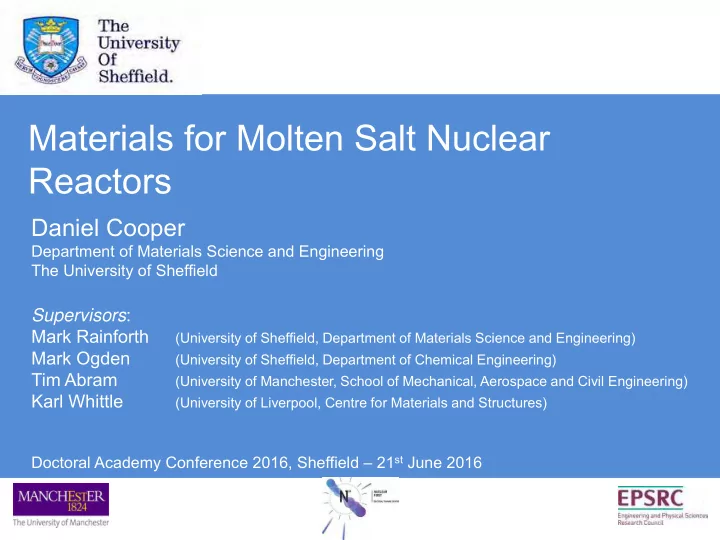

Materials for Molten Salt Nuclear Reactors Daniel Cooper Department of Materials Science and Engineering Daniel Cooper The University of Sheffield Department of Materials Science and Engineering The University of Sheffield Supervisors : Mark Rainforth (University of Sheffield, Department of Materials Science and Engineering) Supervisors : Mark Ogden (University of Sheffield, Department of Chemical Engineering) Mark Rainforth (University of Sheffield, Department of Materials Science and Engineering) Karl Whittle (University of Liverpool, Centre for Materials and Structures) Mark Ogden (University of Sheffield, Department of Chemical Engineering) Tim Abram (University of Manchester, School of Mechanical, Aerospace and Civil Engineering) Tim Abram (University of Manchester, School of Mechanical, Aerospace and Civil Engineering) Karl Whittle (University of Liverpool, Centre for Materials and Structures) Doctoral Academy Conference 2016, Sheffield – 21 st June 2016
Contents • The need for nuclear power • How can we improve nuclear power? • What is a molten salt nuclear reactor? • Materials challenges • Corrosion of materials • What do I do? 2
Correlation of GDP per capita and power consumption David J. C. MacKay, Sustainable Energy – Without the Hot Air, 2008, p.231 3
Worldwide Greenhouse Gas Emissions David J. C. MacKay, Sustainable Energy – Without the Hot Air, 2008, p.12 4
Why Nuclear Power? One uranium fuel pellet in today’s reactors provides the same energy as about one ton of coal Higher energy density ⇒ less land & less waste 5
“But Dan, what about nuclear waste?” The really bad waste, the stuff that lasts thousands of years, from all past and future nuclear power in the UK is enough to fill just 95 double decker buses… NDA, DECC, 2013 UK Radioactive Waste Inventory: Waste Quantities from all Sources, 2013 6
Current Nuclear Reactors – Water-cooled 7
Disadvantages of Water-cooled Reactors Left: Fukushima Dai-ichi underwent rapid pressure loss as a result of a hydrogen explosion. Pressurisation ⇒ Safety risk and added cost Right: Fuel rods, before and after Solid fuel ⇒ premature removal, lower fuel use and added cost Top Left: EPA/TEPCO. Bottom Right: Olander, Journal of Nuclear Materials, 389 , 1-22 (2009) 8
What should we change? Design the reactor so that in an accident it shuts down naturally This will make it cheaper and safer Use a liquid fuel to avoid the problems with solid fuel This will allow the fuel to stay in the reactor longer Design our reactors so that they can utilise waste material as fuel 9
Molten Salt as a Coolant Change coolant from water to molten salt – no need to pressurise H 2 O H 2 O H 2 O Air H 2 O H 2 O H 2 O Solution Cl - Na + Na + Cl - Cl - H 2 O H 2 O Na + Na + Cl - H 2 O Na + Cl - H 2 O H 2 O H 2 O H 2 O Cl - Na + Na + Cl - Cl - H 2 O H 2 O H 2 O Weaker Hydrogen Bonds Stronger Ionic Bonds 10
Molten Salt Reactors 11 GIF-002-00, “A Technology Roadmap for Generation IV Nuclear Energy Systems”, December 2002.
History of molten salt reactors Aircraft Reactor Experiment (ARE), 1954 Molten Salt Reactor Experiment (MSRE), 1965-1969 Change of policies, funding lost because other projects were further developed Left: Proving the Principle by Stacy, Susan M., U.S. Department of Energy, Idaho Operations Office. ISBN 0-16-059185-6, chapter 13. 12 Right: ORNL Photo 67051-64.
Materials Requirements High- High temperature melting mechanical point strength Materials requirements Resistant to Corrosion radiation resistant damage 13 Ignatiev and Surenkov, “Material Performance in Molten Salts”, Comprehensive Nuclear Materials , 2012, pp. 221-250.
Which materials? Plastic? Glass? ✗ High melting point ~ High melting point ✗ Mechanical properties ✗ Mechanical properties ✗ Radiation damage resistant ✓ Radiation damage resistant ~ Corrosion Resistant ✓ Corrosion Resistant Ceramic? Metal? ✓ High melting point ✓ High melting point ✓ Mechanical properties ~ Mechanical properties ✓ Radiation damage resistant ✓ Radiation damage resistant ✓ Corrosion Resistant ✓ Corrosion Resistant 14
Basics of Corrosion E. McCafferty, Introduction to Corrosion Science, 2010. 15
Corrosion in Molten Salts 𝑃 2() + 4𝑓 − ⇌2𝑃 2− 𝐼 2 𝑃 + 2𝑌 − ⇌𝑃 2− + 2𝐼𝑌 𝐼 2 𝑃 + 𝑌 − ⇌𝑃𝐼 − + 𝐼𝑌 Oxygen and water removed to prevent corrosion Use argon gas to maintain pressure, chemically unreactive Still get corrosion driven by fuel, waste and salt movement 16
What do I do? Mechanical alloying Spark plasma sintering 2. Prepare Micropreparation samples of materials 1. Use understanding of properties 3. Expose to to drive molten salts material choice 4. Create 5. Examine electrical materials after circuits to corrosion understand reactions 17
Metals, Binary Carbides and M n+1 AX n Phases Metal Carbide M n+1 AX n Phase Transition Metal e.g. Titanium Carbide e.g. Titanium Aluminium Carbide e.g. Titanium 18
M n+1 AX n Phases – Structure and Properties Ceramic Metallic Strong Ductile High temperature Machinable oxidation resistant High temperature Thermally and corrosion resistant electrically conductive n = 1 ⇒ 211 n = 2 ⇒ 312 Creep resistant Thermal shock resistant n = 3 ⇒ 413 Whittle et al., 2010, Acta Mater. , 58 , 13, 4362. 19
What is the impact of this research? Chemical My Work properties of MAX phases High- Molten Salt Application temperature Jet Turbine Nuclear chemical Blades Reactors processing Cheaper, more Longer material Improved fuel Effect efficient nuclear lifetime, efficiency for air power reduced cost travel 20
Recommend
More recommend